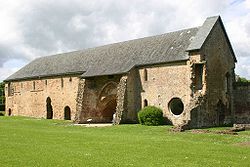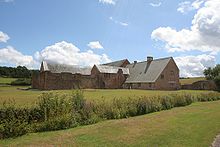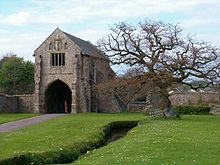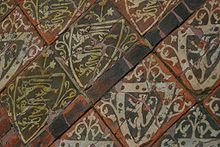- Cleeve Abbey
-
Cleeve Abbey 
The Dormitory at Cleeve Abbey — viewed from the North-EastMonastery information Full Name The Abbey Church of St Mary, Cleeve, Vallis Florida (Latin: 'Flowering Valley') Order Cistercian Established 1198 Disestablished 1537 Mother house Revesby Abbey Dedicated to Virgin Mary Diocese Diocese of Bath and Wells Controlled churches Cleeve, St Joseph's Glastonbury, East Camel, Woolavington People Founder(s) William de Roumare, Earl of Lincoln Important associated figures John Hooper Site Location Washford, Somerset, United Kingdom Coordinates 51°9′20″N 3°21′51″W / 51.15556°N 3.36417°WCoordinates: 51°9′20″N 3°21′51″W / 51.15556°N 3.36417°W Visible Remains complete cloister buildings in habitable state, church and infirmary are missing Public Access yes (English Heritage) Cleeve Abbey is a medieval monastery located near the village of Washford, in Somerset, England. The abbey was founded in the late twelfth century as a house for monks of the austere Cistercian order. Over its 350-year monastic history Cleeve was undistinguished amongst the abbeys of its order, frequently ill-governed and often financially troubled. The sole member of the community to achieve prominence was John Hooper, who became a bishop during the Reformation.
In 1536 Cleeve was closed by Henry VIII in the course of the Dissolution of the Monasteries and the abbey was converted into a country house. Subsequently, the status of the site declined and the abbey was used as farm buildings until the latter half of the nineteenth century when steps were taken to conserve the remains. In the twentieth century Cleeve was taken into state care; the abbey is now looked after by English Heritage and is open to the public. Today Cleeve Abbey is one of the best-preserved medieval Cistercian monastic sites in Britain. While the church is no longer standing, the conventual buildings are still roofed and habitable and contain many features of particular interest including the 'angel' roof in the refectory and the wall paintings in the painted chamber.
Contents
Foundation
The abbey was founded by William de Roumare, Earl of Lincoln[1][2] between 1186 and 1191, on land he had been given by the king. A colony of 12 monks led by Abbot Ralph arrived at the site from Revesby Abbey in Lincolnshire.[2] The official name of the abbey was Vallis Florida (Latin: 'Flowering Valley') but throughout its history it was generally known as Cleeve after the nearby village.
Abbey buildings
Work immediately began on constructing the abbey church, a task that took many decades. It was a conservative design, heavily influenced by the thoughts of St. Bernard and the order's early churches in its homeland of Burgundy.[3] It was cruciform in shape with an aisled nave of seven bays, a short, square east end, and transepts each with two side chapels. The eastern parts of the church were built first, and were likely finished in 1232, at which point the abbey received a royal donation of oak to build choir stalls.[2] The remainder was probably completed by mid-century.
To the south of the church a cloister was laid out, surrounded by the domestic buildings of the house. The east range, which was completed first (probably by around 1250),[3] held the chapter house, sacristy, the monks' dormitory, day room, and reredorter (latrine). The south range was built next, it contained the kitchens, warming house and a 19.7 m long refectory which projected south beyond the main body of the building, a classic Cistercian plan. It is suggested from the heraldry used in the tiled floors of the refectory that it was finished at the end of the thirteenth century.[3] The final part to be finished was the small west range, which was used for storage and quarters for the lay brothers. East of the core buildings, and linked to them, was a second cloister around which was the monastic infirmary.
The monastery would have been surrounded by gardens, fishponds, orchards, barns, guesthouses, stables, a farmyard and industrial buildings. The abbey grounds were defended by a water filled moat and a gatehouse.[3] Excavation has revealed that a large stone cross, like a market cross, stood just west of the main building.[4]
Though Cleeve was by no means a wealthy house, the monks were able to make significant investment in remodelling their home so as to match the rising living standards of the later mediaeval period. In the fourteenth century elaborate polychrome tiled floors (an expensive and high status product) were laid throughout the abbey and in the mid-fifteenth century radical works were undertaken. Abbot David Juyner (r. 1435–87) commissioned a complete redesign of the south range of the monastery.[5] He demolished the old refectory and built a new one parallel to the cloister on the first floor. This grand chamber with its wooden vaulted ceiling (carved with angels) was the equal of the hall of any contemporary secular lord.[6] Beneath it he built several self-contained apartments. These were probably used by corrodians, pensioners of the abbey.[5] Juyner may also have been responsible for decorating the abbey with wall paintings of religious and allegorical subjects.[3] Some of these wall paintings survive. As well as one depicting the Crucifixion, there is an arrangement of St Catherine and St Margaret on either side of, and facing, a man standing on a bridge: the bridge is over water full of fish, and the man has an angel on either side of his head, and is being attacked by a lion to his left on the bridge, and a dragon to his right.[7] Work continued under Juyner's successors right up until the eve of the Dissolution. The last building work to be completed was the remodelling of the gatehouse, performed after 1510, though as late as 1534 the monks were engaged in a major project of renewing the cloister walks in the latest fashion.[2] As at the neighbouring house of Forde Abbey, this was never completed, due to the dissolution of the abbey.[8]
Monastic History
Like most of the smaller Cistercian houses, comparatively little is known about the internal history of the abbey.[2] In its early years Cleeve received grants of land and property from local lords and the Crown to supplement its initial endowment and in the prosperous years of the thirteenth century grew steadily, reaching 26 monks in 1297.[2] A major source of income was the export of wool. However, the fourteenth century saw a change in fortunes: the Black Death, a worsening economic climate and poor administration left the abbey (like many others of its order) with sharply declining numbers and saddled with major debt. The internal discipline and morals of the community declined too: in 1400–1401 it was reported to the government that the abbot of Cleeve and three other monks were leading a group of 200 bandits and attacking travellers in the region.[9] However, things improved in the fifteenth century and despite the vast expense caused by the extravagant building projects of the last abbots, better management, access to new resources (for instance from the profits from the right to hold markets granted by the crown)[2] and a general improvement in the circumstances facing the house meant that just prior to the dissolution Cleeve was enjoying an Indian Summer of comfortable stability.
Dissolution
In 1535, the abbey's income was only assessed at £155[2] in the Valor Ecclesiasticus, the Henry VIII's great survey of church finances. It meant the following year that it came under the terms of the first Suppression Act, Henry's initial move in the Dissolution of the Monasteries. Abbot William Dovell and his 16 monks were forced to surrender the abbey on September 6th 1536. There were proposals from local gentry and even some of the king's officials for the Dissolution such as Sir Thomas Arundell that Cleeve should be granted a reprieve,[2] as a number of others among the smaller monasteries were, however, it was not to be and the monks finally left in the spring of 1537.[2] Abbot William was given a pension of 40 marks per year, not large but certainly comfortable, which he was still drawing 20 years later.[2] Most of the other monks were given pensions too. One former monk of Cleeve rose to prominence and came to a sticky end. This was John Hooper[2] who became Bishop of Gloucester and Worcester and was killed in 1555 for his protestant beliefs by Mary I.
Later history
Soon after Cleeve became Crown property, it was leased to Anthony Busterd for 21 years.[8] In 1538, the freehold of the site was granted to Robert Radclyffe, 1st Earl of Sussex. The church was demolished, save for the south wall which bounded the cloister, and the rest of the abbey converted into a mansion suitable for a gentleman. By the early seventeenth century, however, Cleeve had turned into a farm.[8] The dormitory was now a large barn, the cloister was the farmyard and the rest of the buildings were used for agricultural purposes and a farm house.[9]
George Luttrell of Dunster Castle acquired the site in 1870. The abbey stopped being used as a farm and extensive archaeological excavations took place.[8] The farm house was converted into rental cottages, and the site became a tourist attraction.
Cleeve Abbey was passed back to the Crown in 1950–51[8] to pay Death Duties on the Luttrell estate. Major restoration and archaeological work followed.[8] In 1984, English Heritage took over responsibility for Cleeve Abbey, carrying out excavations and earthwork surveys[10] and continues to care for it today.
Present day
The church and infirmary have almost entirely vanished, but the site boasts some of the finest and best-preserved monks' living quarters still surviving in Britain. The buildings round the cloister are still roofed and habitable and many of the rooms retain their vaults. Among the most important preserved rooms are the chapter house, the refectory with its magnificent arch braced wooden vault and the painted chamber. Much of the abbey's medieval tiled flooring remains. Other major survivals include the abbey gatehouse, which still provides entrance to the visitor, the moat and fishponds. Cleeve is open to the public.
The remains of the buildings have been designated by English Heritage as a grade I listed building, and it is listed as a Scheduled Ancient Monument.[11]
Literary Associations
The Abbey was the original site on which 'Gracedieu', the setting for the Abbey Series of books by Elsie J. Oxenham, was based. Many of its features described by Oxenham, who visited Cleeve in the early years of the Twentieth Century, can be identified at the site today, although literary licence allowed her to add features from elsewhere or from her imagination.
Film and television
The Castle scenes in the children's musical-comedy television series Maid Marian and her Merry Men were filmed in Cleeve Abbey.
See also
- List of Grade I listed buildings in West Somerset
Notes
- ^ Leete-Hodge, Lornie (1985). Curiosities of Somerset. Bodmin: Bossiney Books. p. 43. ISBN 0906456983.
- ^ a b c d e f g h i j k l William Page, ed (1911). Houses of Cistercian monks: The abbey of Cleeve. A History of the County of Somerset. II. pp. 115–118. http://www.british-history.ac.uk/report.aspx?compid=40927.
- ^ a b c d e Robinson, David; Janet Burton, Nicola Coldstream, Glyn Coppack & Richard Fawcett (1998). The Cistercian Abbeys of Britain. Batsford Ltd. p. 86. ISBN 978-0713483925.
- ^ Details, Somerset HER
- ^ a b Robinson, David; Janet Burton, Nicola Coldstream, Glyn Coppack & Richard Fawcett (1998). The Cistercian Abbeys of Britain. Batsford Ltd. p. 87. ISBN 978-0713483925.
- ^ Platt, Colin (1984). The Abbeys and Priories of Medieval England. Secker & Warburg. pp. 157–158. ISBN 978-0436375576.
- ^ James, Montague Rhodes (1926). Abbeys. The Ballantyne Press. p. 125. "This picture represents, I have no doubt, the temptations or perils of the Christian".
- ^ a b c d e f Robinson, David; Janet Burton, Nicola Coldstream, Glyn Coppack & Richard Fawcett (1998). The Cistercian Abbeys of Britain. Batsford Ltd. p. 110. ISBN 978-0713483925.
- ^ a b James, Montague Rhodes (1926). Abbeys. The Ballantyne Press. pp. 124–126.
- ^ "Cleeve Abbey, Washford". Somerset Historic Environment Record. Somerset County Council. http://webapp1.somerset.gov.uk/her/details.asp?prn=33918. Retrieved 13 July 2008.
- ^ "Cleeve Abbey". Images of England. English Heritage. http://www.imagesofengland.org.uk/Details/Default.aspx?id=264814. Retrieved 13 July 2008.
Bibliography
- Cleeve Abbey, Stuart A. Harrison, English Heritage 2000 ISBN 1-85074-760-1
External links
- English Heritage: Cleeve Abbey
- Official website about the abbey from Somerset County Council
- Detailed historical record for Cleeve Abbey
Categories:- History of Somerset
- Monasteries in Somerset
- Visitor attractions in Somerset
- Cistercian monasteries in England
- 1186 establishments
- West Somerset
- Grade I listed buildings in Somerset
- Scheduled Ancient Monuments in Somerset
- English Heritage sites in Somerset
- Christian monasteries established in the 12th century
- Museums in Somerset
- History museums in Somerset
- Religious museums in the United Kingdom
Wikimedia Foundation. 2010.






